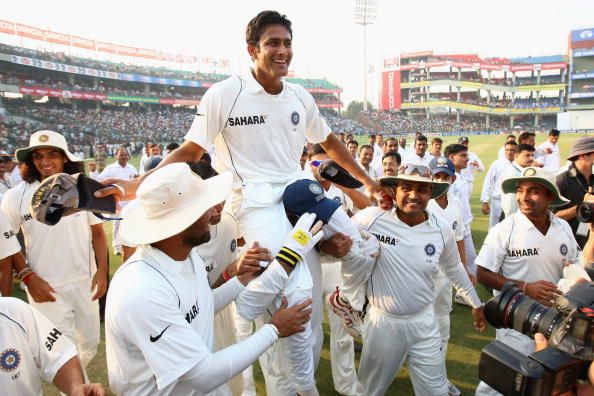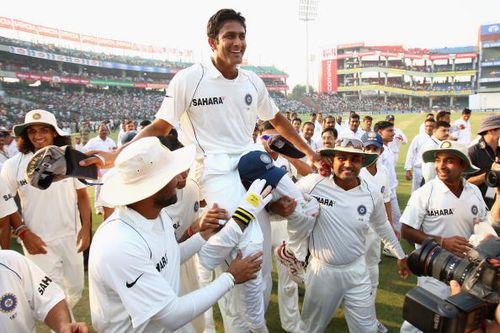
Legends of yore: The unpoetic, unromantic and imperfect tale of Anil Kumble

Indian captain Anil Kumble is chaired round the pitch on a lap of honour by his team mates after announcing his retirement from Test cricket during day five of the Third Test match between India and Australia at the Feroz Shah Kotla Stadium on November 2, 2008
Ask any cricket fan who the Don Bradman of leg-spin is and I can bet a million dollars (and be sure to collect) that the answer wouldn’t be Anil Kumble. Anil Radhakrishnan Kumble typifies the phrase “born in the wrong era”. In a generation that boasted of spinners like Muttiah Muralitharan, Shane Warne and Saqlain Mushtaq, this stern-looking leg-spinner from India remained nondescript for the most part of his 18-year-long career. For unlike his counterparts, he had neither the flair nor the flamboyance to captivate the crowd. Nor did he possess the innovative genius of Saqlain Mushtaq. Throughout the span of his career, he was constantly criticized for his lack of ability to derive lateral turn and his alleged ineffectiveness away from home. For the better part of almost two decades, he gritted down on all the jeers about how he was more of a medium-pacer than spinner.
His answer to his critics came on 17th January 2008 in Perth when he quietly acknowledged his 600th scalp, holding the cricket ball proudly above his head with his left hand as a salute to the applauding crowd. From a statistician’s point of view, Kumble’s career is a host of numerous unparalleled records, some of which might never even be repeated.
- He is the only other bowler, apart from Jim Laker, to claim all the ten wickets in an innings
- His career total of 619 test wickets (350 Home vs. 269 Away) is the third highest in cricket history, after Murali’s 800 and Warne’s 708.
- He was the first spinner to take 200 ODI wickets.
- He holds the record for most number of dismissals in the form of LBW, with a little over 25% of his victims dismissed that way.
- He also holds the record for the most number of dismissals in the form of caught & bowled.
- Kumble’s 118 matches is the highest number of matches taken by a player get to his maiden Test century.
These are, without a doubt, accomplishments that truly befit a champion cricketer. But Kumble is more than just the sum of his accomplishments; one must know the story beyond these records to understand why.
In 1990, when Azharuddin first tossed the ball to Kumble – this 19-year old bespectacled kid who looked like he was plucked right out of his classroom – neither of them would have ever imagined that Kumble would eventually surpass Kapil Dev to go on to become the leading wicket-taker for India. Kumble had a very forgettable debut where he conceded 168 runs with only three wickets (all of which came in the first innings) to show for. After a couple more chances in ODIs, Kumble was dropped from the Indian squad. It was almost two years before he made his way back into the team after a spectacular domestic season. In those two years, Kumble graduated from college, and so did his bowling. Starting with the South Africa series in November 1992, Kumble picked up wickets steadily, slowly becoming the spearhead of an Indian spin attack that was going through a transition phase.

Kumble’s, unconventional, pacer-like bowling action
Kumble was not a prodigious turner of the ball like his Australian counterpart. He relied on his accuracy, pace and bounce to compensate for lack of spin – this is surprising considering that he hails from Karnataka, a state that produced some of the finest Indian spinners like Bhagwat Chandrasekhar and Erapalli Prasanna. One must skip back to Kumble’s early cricketing days to better understand the reason for this. Kumble started off his career as a medium-pacer before he was called for chucking in his school days. Following his brother’s advice, he took up leg-spin; but the action and attitude of a medium- pacer remained. As his career progressed, he gradually transformed his bowling into a hybrid between the medium-pace from his early days and the leg-spin of his idol, Chandrasekhar. The more adept he got at this new genre of bowling he created, the more successful he became. He earned himself the nickname Jumbo – not just for his jumbo sized feet, but because of his deliveries which travel like jumbo-jets through the air. His characteristic style involved spinning webs around the batsmen and carefully setting them up before snagging them with a flipper, which was the bread-and-butter delivery for Kumble. Thus, it is no surprise that a quarter of his victims were caught trapped in front of the stumps.
Kumble’s career peaked in 1999 when he claimed the wickets of all ten Pakistani batsmen in the fourth innings. When he got 9 Pakistani batsmen out, Wasim Akram came in to face the ball which could have given Kumble his first hat-trick and a ten-wicket haul. The entire cricketing world was on the edge of their seats to witness what would have been a perfect climax to a once-in-a-lifetime spectacle. But Akram defended away, denying Kumble his maiden hat-trick. It took some (intentionally) ludicrous bowling from an in-form Javagal Srinath, a (unintentionally) dropped catch by Sadagoppan Ramesh and a nervous few balls before Kumble could finally get to his milestone. The world was suddenly abuzz with the chant of Anil Kumble.
The following year, a shoulder injury ruled him out of the game for 10 months and Kumble was back to the sidelines again. That is how his career was – a series of highs and lows in quick succession. His resilience was so great that whenever he fell down, he bounced back to greater heights. He made a brilliant comeback in late 2001 taking wickets on a consistent basis in South Africa and the subcontinent before heading off to the tour of West Indies in April 2002. In the fourth Test against the West Indies that series, Kumble briefly made the headlines again when he got the prized wicket of Brian Lara after bowling with a broken and bandaged jaw. When asked in an interview if he feels bad for not receiving the recognition that he deserves because of his unorthodox action, he replied that it was the recognition of his team mates that mattered the most to him and as long as his team trusted him with the ball to get wickets for them, it was good enough for him.

Kumble came back to bowl and dismiss Brian Lara, after being struck by a nasty bouncer that broke his jaw; an event that exemplifies his commitment to the team
The following years saw Kumble rise in Test cricket and, at the same time, lose out to younger spinners for a spot in the ODIs. While the selectors repeatedly deemed him unfit for the shorter format of the game, he surpassed milestones that were set by the ones that preceded him and started creating a few of his own in the longer format. When Rahul Dravid stepped down as the Test skipper and Tendulkar refused the post, Kumble was given the helm of the Indian Test team at 37. His short stint as the skipper featured some aggressive but level-headed and emotionally sound leadership, especially in Australia (2007)- one of the most controversial series in the recent times. The same year, he scored his maiden Test century, taking 118 matches to achieve it. This one-off century wasn’t a fluke. Kumble had 7 centuries and 17 half centuries at the domestic level. He failed to translate his domestic batting form to the international level. He came close a couple of times with 78 and 88 before he was run-out on both the occasions. His reaction after reaching his maiden Test ton showed how painful the wait was.
Five months later, the much-awaited 600th wicket came when Andrew Symonds edged one to Dravid at first slip. But Kumble’s exultation at getting his 600th wicket was short-lasted as he was in and out of form and the pressure for him to retire was constantly mounting. After a extended lean patch, his retirement came under immense pressure at his favourite cricket ground – Feroz Shah Kotla. He could only manage three wickets in the first innings and none in the second, while the Test ended as an uninteresting draw. His last wicket was the tenth of the Australian first innings – a brilliant running catch off his own bowling. His gesture of throwing the ball at the stumps in disgust after completing the catch was a not-so-subtle dig at his critics. His last delivery at the international level was a low full toss that was smashed for a four.
Kumble did not have a dream start to his career, nor did he have a fairy-tale end. His was not a fantastic fable full of magical accomplishments. But at every point in his journey, he fought tooth and nail to make it one. And that is what makes the unpoetic, unromantic and imperfect tale of Anil “Jumbo” Kumble that much more heroic.